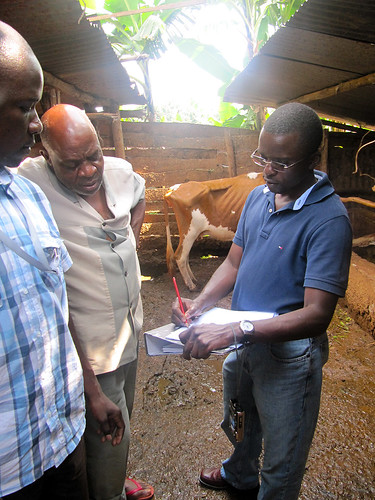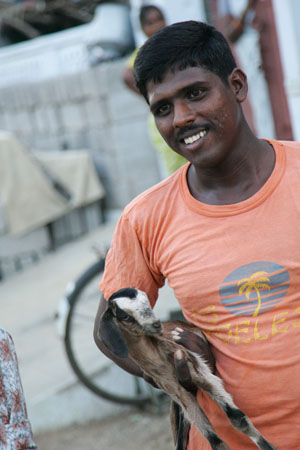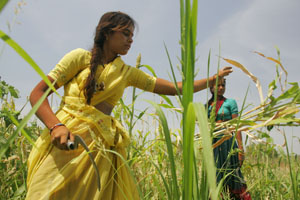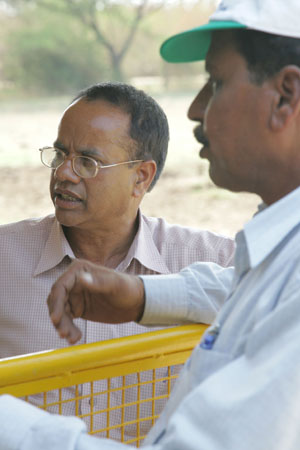 Livestock scientists from ILRI and the Clinical Studies Department of the University of Nairobi (UON) recently succeeded in breeding Kenya’s first test-tube calf using a technique called in vitro embryo production (IVEP). IVEP makes it possible to rapidly multiply and breed genetically superior cattle within a short generation interval.
Livestock scientists from ILRI and the Clinical Studies Department of the University of Nairobi (UON) recently succeeded in breeding Kenya’s first test-tube calf using a technique called in vitro embryo production (IVEP). IVEP makes it possible to rapidly multiply and breed genetically superior cattle within a short generation interval.
Why is this important?
For several reasons. First, livestock is the fastest growing sub-sector in the world, as increasing trends of 114% in demand for meat and 133% for milk attest. To improve on food security, it is essential to double livestock production in the developing world by 2020. IVEP is clearly one of the most efficient ways to accomplish this.
Second, let’s consider the problem of environmental impact. Doubling livestock production through traditional breeding techniques increases pressure on natural resources—water, land and biodiversity. So the need for enhanced efficiency without degrading natural resources is urgent. Again, IVEP, which requires only laboratory equipment in the production process, comes to the rescue.
Third, there is the biodiversity issue. Matching genotypes to environment is crucial. Scientists need to take several factors into consideration—among them adaptation, tolerance for disease, tolerance for new environments and alignment to market development. Although plenty of genetic diversity exists, thus far we’ve done little with it. Once more, IVEP could be the answer.
Fourth, IVEP has significant commercial potential because farmers can rent their best cows as donors and their lower-quality cows as surrogates.
Most importantly, we need to look closely at the constraints faced by small-scale livestock keepers.
- Cattle genotypes and production environments, as often as not, do not match. Result:Â low productivity.
- Heifer replacement programs take a long time and are rarely done properly. Result: supply is low, prices are high.
- Sex ratios are often disadvantageous. Result: too many males and high production costs.
- The commercial relevance of many indigenous breeds is not optimised. Result: farmers incur unsupportable losses.
- Programs for breed conservation and preservation are often improper. Result: some breeds are threatened by extinction and no gene pool for replacement exists.
IVEP does not—and should not—completely replace traditional reproductive technologies such as conventional embryo transfer (ET) and artificial insemination. Each of these techniques has its place, and each of them utilizes tissues, embryos and semen for improvement and reconstruction of cattle breeds. The difference is that while the traditional ET techniques involve more animals and are wholly done in the field, IVEP is undertaken in the lab and involves fewer surrogate animals in the field. IVEP eliminates the tedious steps of synchronizing donor cows.
Specifically, IVEP technology as a breeding tool has the distinct advantage of maximizing utilization of appropriate dam and sire genotypes by:
- increasing efficiency of multiplication in breeding;
- permitting determination of sex of the offspring; and
- permitting pre-testing of actual fertility status of the bull.
Thus, while natural mating or artificial insemination are necessarily slow and inefficient, producing only 10-15 offspring per life span of a cow …

…IVEP can produce up to 300 offspring per life span.

The SIFET Project: a successful IVEP program
The Sexed semen in-vitro fertilization and embryo transfer (SIFET) project was designed to exploit and promote the potential of applying IVEP reproductive technique to:
- develop, multiply and disseminate female crossbreeds that appropriately match with production environment;
- provide a system to preserve top bovine genotypes in cases of accidental culling in a recycle-like scheme (slaughterhouse collection); and
- identify, multiply and conserve selected superior desirable breed traits.
The project involved collecting ovaries from slaughter houses or picking ovum from live cows. When the genetic material is brought to the lab, oocytes with high developmental competence are selected and morphological evaluation done. Once the ideal oocytes are identified, they are matured in vitro for 22-24 hours. The subsequent in vitro fertilization process is conducted for a period of 18-22 hours with a high sperm concentration. The fertilization itself requires removal of seminal plasma and extenders, separation of motile sperms from dead ones and induction of sperm capacitation. Once the embryos are formed, they are cultured in the lab for 7 days and then transferred to surrogates.
A conception rate of about 40% has been achieved, with calves born without abnormalities.
Conclusions
- IVEP technology is feasible in Kenya.
- Commercialization of the process should be facilitated as soon as supportive policies and proper legal/regulatory frameworks are in place
Challenges
Poor field heat detections leading to poor uterine synchrony and lower conceptions are concerns, as is the high genotype variability characteristic of animals brought to slaughterhouses.
Way forward and prospects
Looking ahead, the collaborating scientists anticipate bringing ovum pick-up (OPU) and cryopreservation into the picture as well as capacity building.
Clearly, such programs can help match breeds to appropriate production systems to ensure sound breeding programs. Where and when necessary, new breeds can be introduced within a relatively short period of time. Above all, embryos are far easier to transport across continents than live animals.
Through IVEP technology and well-planned crossbreeding programs such as SIFET that integrate the use of indigenous cows as donors and surrogates while using semen from appropriate (more productive and reasonably adapted) dairy breeds such as Jerseys, F1 heifers suited to the smallholder farmers’ conditions can be produced.
Niche markets for the technology and its F1 products should be further explored and exploited, notably with regard to the potential of forestalling the threat to key wildlife species.
Acknowledgements
Funding for the project was made available by Heifer Project International. UON provided the technical team and recipient animals. Administration and laboratory facilities were provided by ILRI. The cooperation of the abattoirs (the source of ovaries) and the animal owners are gratefully acknowledged. The capacity building program through a joint CNPq grant for the Embrapa-UON-ILRI partnership, as well as support from Dr Luiz Carmago and Dr Joao Viana of Embrapa, are highly appreciated.
The collaborating scientists are Mwai Okeyo, Henry Mutembei and Bridgit Syombua from ILRI; and Erastus Mutiga, Victor Tsuma and Henry Mutembei from Clinical Studies, UON.
For more information, contact Dr Okeyo Mwai, Animal Geneticist/Breeder, Biotechnology Theme, ILRI, at o.mwai@cgiar.org.


 Livestock scientists from ILRI and the Clinical Studies Department of the University of Nairobi (UON) recently succeeded in breeding Kenya’s first test-tube calf using a technique called in vitro embryo production (IVEP). IVEP makes it possible to rapidly multiply and breed genetically superior cattle within a short generation interval.
Livestock scientists from ILRI and the Clinical Studies Department of the University of Nairobi (UON) recently succeeded in breeding Kenya’s first test-tube calf using a technique called in vitro embryo production (IVEP). IVEP makes it possible to rapidly multiply and breed genetically superior cattle within a short generation interval.






 Dr Iain A Wright
Dr Iain A Wright